THE LIBERO IN VOLLEYBALL
Topics Covered In This Article
- An introduction of the libero position in volleyball for new coaches.
- The rules surrounding the libero.
- An example of how liberos enter/exit the court during a game.
- The general job description of a libero.
- A detailed overview on how to determine where your libero should play on defense (middle back or left back).
What is the libero position in volleyball?
The libero in volleyball is a specialized position that can only play in the back row. They are commonly called “defensive specialists” or “ball-control specialists” as they manage a lot of passing and digging responsibilities.
The reasoning behind adding the libero position in volleyball, which was first introduced in 1998, was to better the ball-control phase of the game. Better ball control allows for more options offensively. This will result in longer, exciting rallies which of course fans enjoy. Note that the libero in volleyball is only utilized in the indoor game.
why does the libero were a different color uniform?
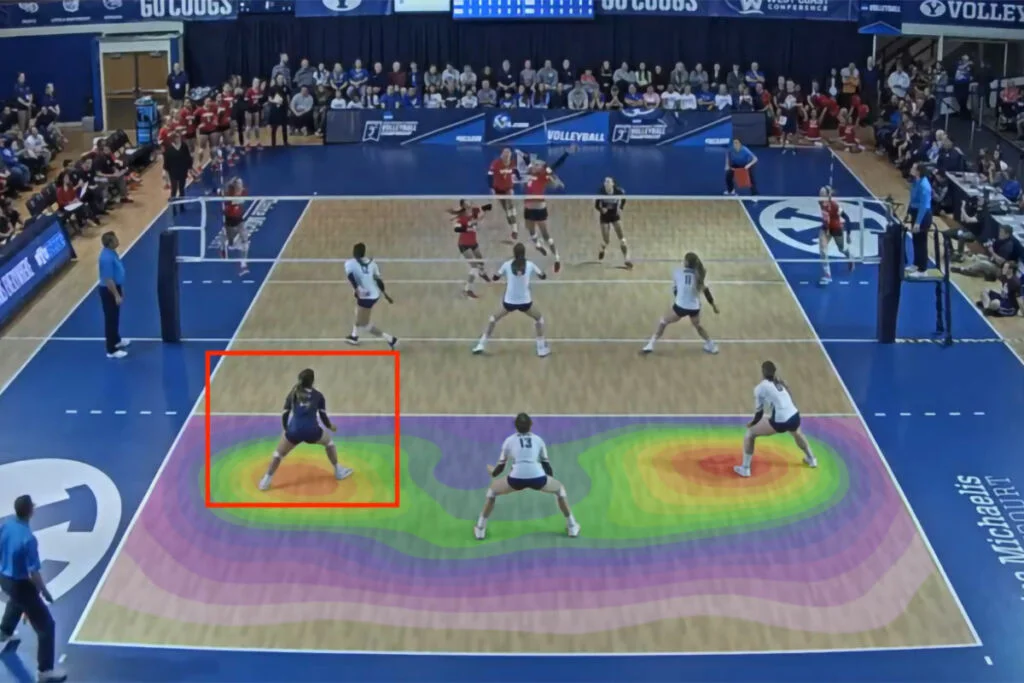 The libero in volleyball is the only player on the court who wears a different color jersey.
The libero in volleyball is the only player on the court who wears a different color jersey.
The different color jersey makes it easy for the referee to track the athlete as they enter and exit the court. This matters because the libero can enter and exit the court on their own and without it counting towards a team’s official substitution limit.
PASSING, DIGGING, OR BOTH?
Ideally, your libero is great at passing in serve-receive AND digging when on defense. If you have a libero who is great at both of these skills, consider yourself lucky! It’s fairly common to have liberos in your gym who are really good at one or the other. Coaches will typically prioritize a passing libero in volleyball over a really good defensive libero, but we will save that for a different conversation.
RULES ABOUT THE LIBERO POSITION
For the average volleyball fan, or for a new volleyball coach, it’s important to understand the basic rules of the libero position.
- The libero in volleyball can “exchange” with a back-row player without it counting as an official substitution. This exchange happens in between rallies. You will see the libero running on/off the court, typically for the back-row middle blocker.
- Only the player who took part in the original libero exchange can replace the libero. For example, if the libero exchanges with a back-row middle blocker, only that middle blocker can exchange again with the libero. Once this round-trip exchange happens, the libero can exchange with the second middle blocker and the cycle continues.
- A libero is not allowed to complete an attack (from anywhere on the court) if the ball is above the top of the net during contact. They can, however, attack so long as the ball is not entirely above the net during contact. This is not a play that you will see often, but it does happen from time to time.
- Liberos are not allowed to block. They are back-row specialists and don’t play in the front row.
- It is permissible for a libero to replace the player in the serving position. In other words, liberos can serve or not serve depending on abilities, strategy, etc.
- It is illegal for a front-row player to attack a ball that was “set” overhead (with hands) if the libero is in front of the 3-meter line. A libero will use a “bump set” when in front of the 3-meter line. A traditional “hand set” can be used when behind the 3-meter line.
- A coach can only designate one libero per set, but changing liberos in between sets is permissible.
These are the most important, and most noticeable rules that will enable a beginner, or a fan, to understand what’s going on.
ADDITIONAL LIBERO CONSIDERATIONS
- Liberos are not required to enter the match.
- Liberos can serve in one rotation. This is a tactical decision typically based on serving abilities. If one of your middle blockers is a poor server, it is permissible for the libero to serve in their place.
- In today’s game, the majority of liberos will set when the setter digs the first ball. For example, if the opposing outside hitter attacks the ball down the line and the defending setter digs it (1st contact), the libero would then take the 2nd contact and the attacker would take the 3rd contact.
AN EXAMPLE OF how the libero enters and exits the match
Step 1: Once the referee confirms the starting lineup (the six non-libero players), the down ref will signal to the libero that they can enter the match for the back row middle blocker (we will call this athlete MB1).
Step 2: When the libero eventually rotates to the front row, they will exchange out for MB1 and MB1 will play through the front row. Because the libero and MB1 have completed a full exchange, it’s now permissible for the libero to exchange with another player.
Step 3: Now that there’s a new back-row middle (MB2), the libero can exchange with them and once again play through the back-row. Once the libero gets back to the front-row, they will complete the full exchange with MB2 and the cycle continues.
where should your libero in volleyball play on defense?
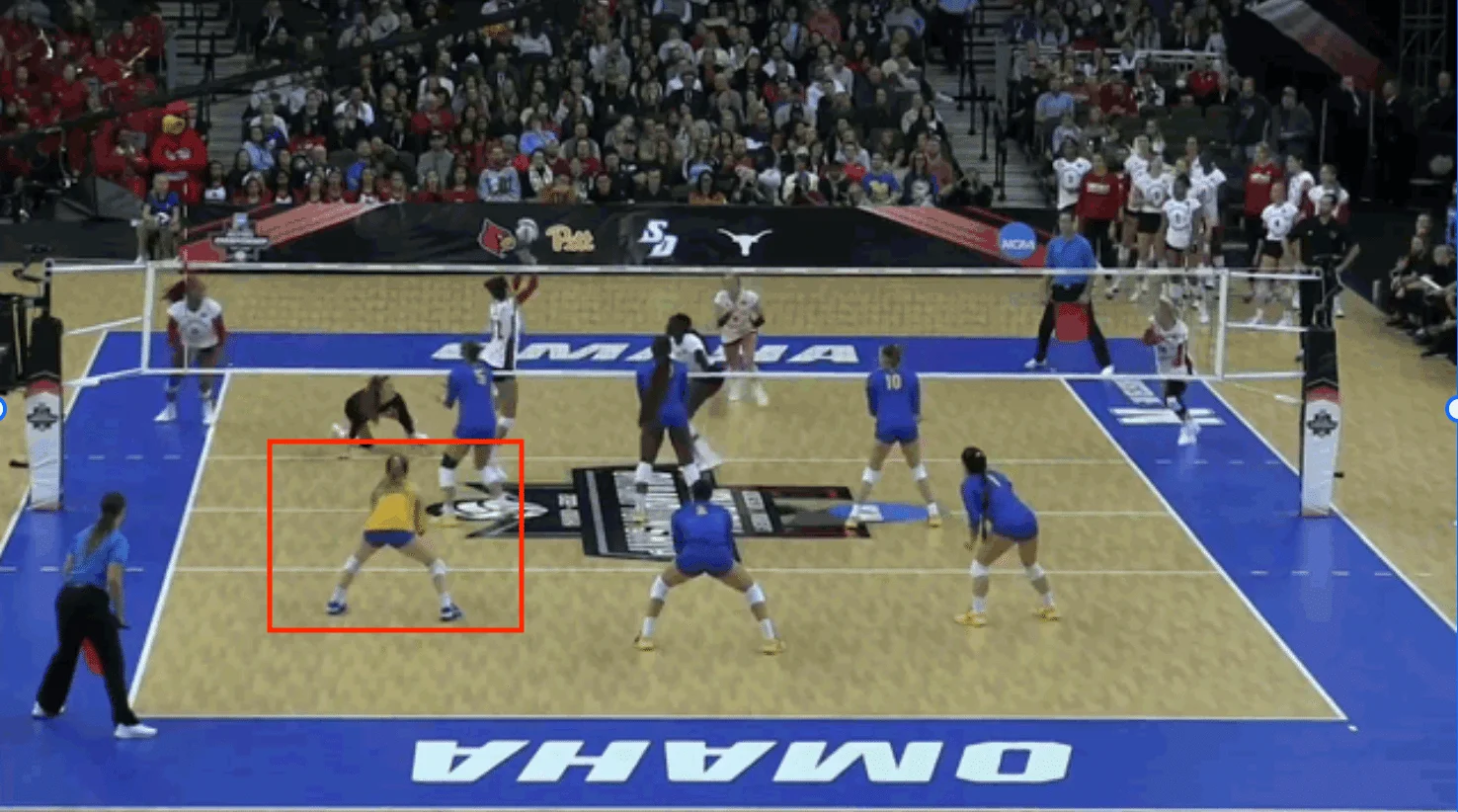 At Gold Medal Squared we want to use coaching principles to build our team systems. When it comes to defensive systems, we have developed science and data-based principles that can simplify the process of building an effective defense, and one that is based on the abilities of your athletes. In this section of our detailed over of the libero in volleyball, we will dive in to back row defense. Specifically, how do we decide where our libero in volleyball should play in the back row?
At Gold Medal Squared we want to use coaching principles to build our team systems. When it comes to defensive systems, we have developed science and data-based principles that can simplify the process of building an effective defense, and one that is based on the abilities of your athletes. In this section of our detailed over of the libero in volleyball, we will dive in to back row defense. Specifically, how do we decide where our libero in volleyball should play in the back row?
KEY PRINCIPLES FOR DEFENSE
- Put your best defenders where most of the balls go. Note, this does not mean blindly placing your libero in the middle of the court (more on this below).
- Put your defenders where things happen the fastest
When you truly understand the value of these principles, you will also realize that they are liberating, not restrictive. Principles will give us a wonderful foundation from which to start. That said, we still have additional considerations to look at.
In order to figure out if your libero should play left-back or middle-back, we will need to answer the following questions.
- Who is the best defender on your team?
- Where do most of the balls go at our level?
- Where do things happen the fastest?
- Do different types of sets place different demands on our defenders?
- Who sets when the setter digs the first contact?
- How does the back-row attack impact where our libero plays?
- Can a libero play in both positions (middle and left back)?
WHO IS THE BEST BACK-ROW DEFENDER ON YOUR TEAM?
Because of the specialized nature of the libero position, it’s not surprising that on most teams, the libero in volleyball is the best (or at least one of the best) defensive players. However, this isn’t always the case. Many times a team will have a single athlete that is the best attacker, best server, best passer, best digger, and best blocker. It shouldn’t be a surprise that this athlete is typically one of your outside hitters.
In short, any player playing any position may be your best defender, but in most situations, this will be your libero and/or outside hitter. You also may have multiple defenders that are equal in their ability to dig. Consider this a luxury as it opens up a few more options for you when designing your defense (discussed later in the article).
Your level matters for two primary reasons. First, collegiate and professional programs have more resources when it comes to gathering data and identifying tendencies. This makes it easier to justify adjustments when developing a game plan. Often times at the juniors level, teams will compete with little to no information prior to the match starting. Why does this matter? Because our number one defensive principle is “put your best defenders where most of the balls go.” If you don’t have this information on your opponent, we can sleep very well at night recommending that high school, club, and even collegiate programs spend a lot of time defending the middle of the court.
Below is a heat map showing us where balls land in women’s college volleyball. The red and pink boxes illustrate that approximately 45% of balls land, or pass through those areas of the court. It’s important to recognize that those four boxes take up a good chunk of the court. We aren’t suggesting that 45% of all balls land directly at the intersection (what we call middle-middle). That said, whoever is playing in or around the middle of the court will need to have defensive range, allowing them to dig a variety of balls within those four areas of the court.
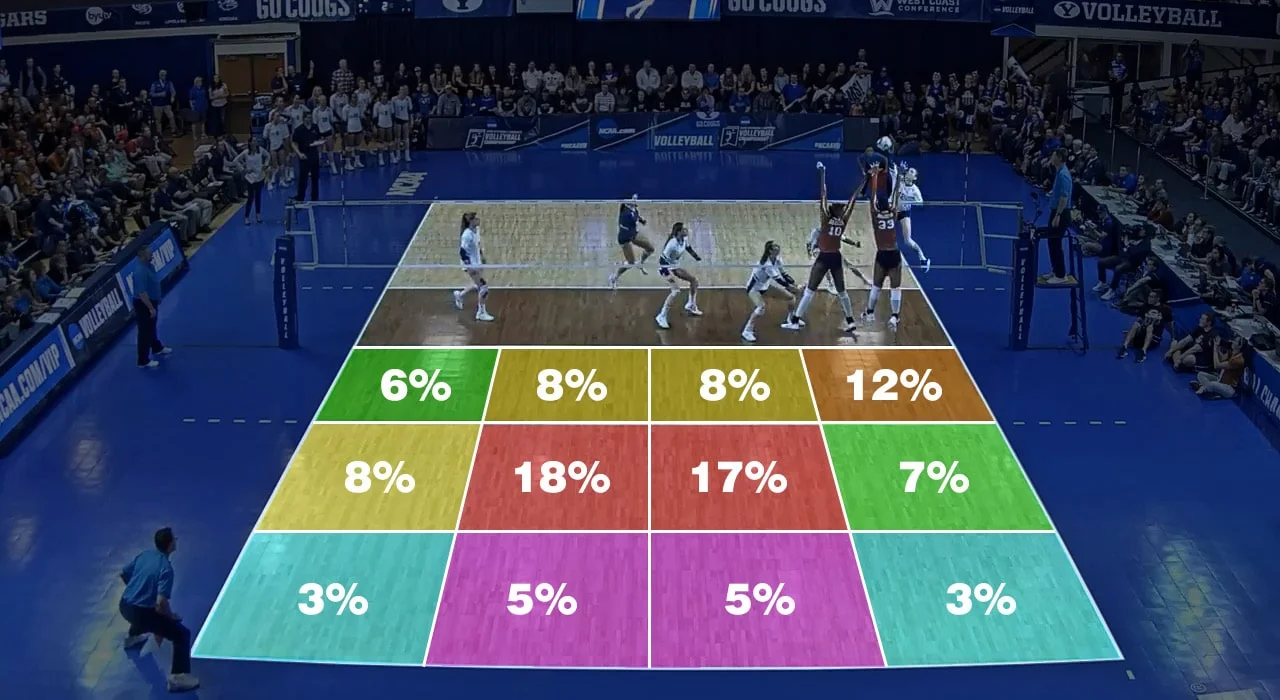
We did a similar study in 2022, which included some of the best high school teams in the country. It’s important that we continuously challenge our current data and bias to ensure we are offering the most up-to-date information. We also added a level of detail, breaking down the court into smaller segments.
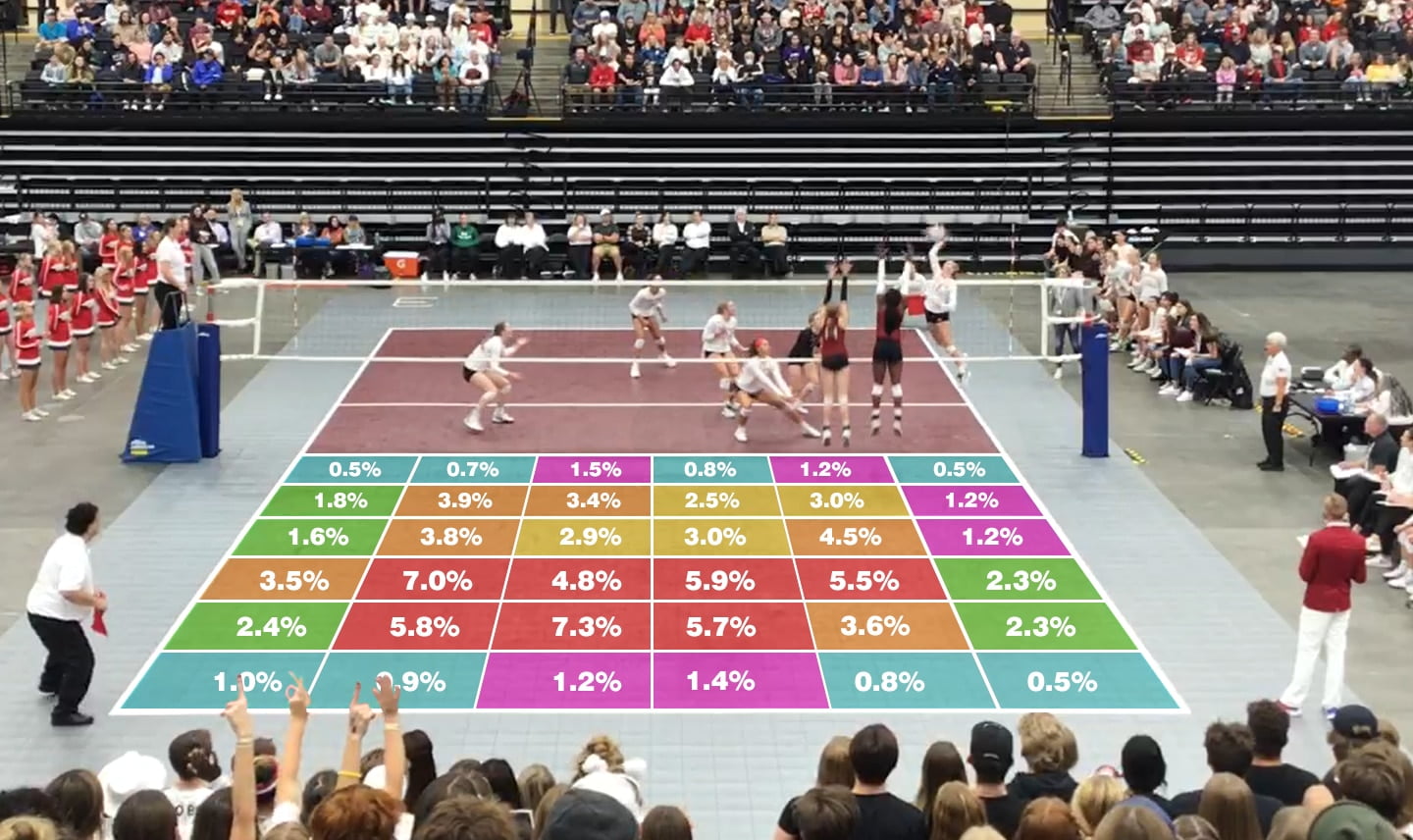
As you can see, top high school levels are generating a very similar pattern. We see a lot of action in the middle of the court, left of the middle, and in area 2 where a lot of tips will go.
Note: These charts show where the ball was contacted by the defender, not where it may end up. Charting where balls may end up adds a layer of complexity (and guesswork), and ultimately we want our athletes in a position to TOUCH as many balls as they possibly can.
WHERE DO THINGS HAPPEN THE FASTEST?
Volleyball is getting faster and more powerful. The speed of the game is certainly a factor we need to consider when deciding where to put our defenders.
When the ball is on the opposing side of the net, the quickest possibility a back-row defender needs to be prepared for is a setter set-over or a setter dump attack. While this play doesn’t happen very often, aggressive setters may require attention from the defense. Examples of both types of attacks are shown below.
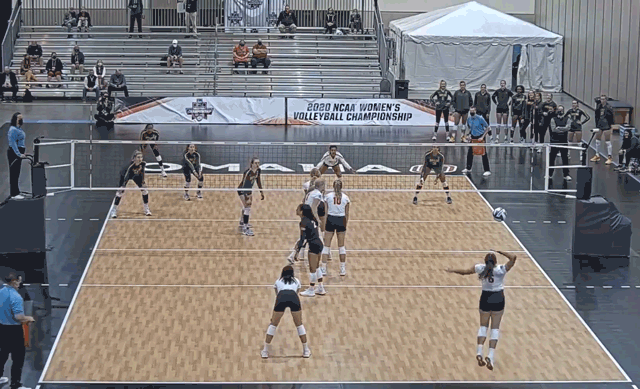
The vast majority of these types of attacks will land shallow middle or in zone 4.
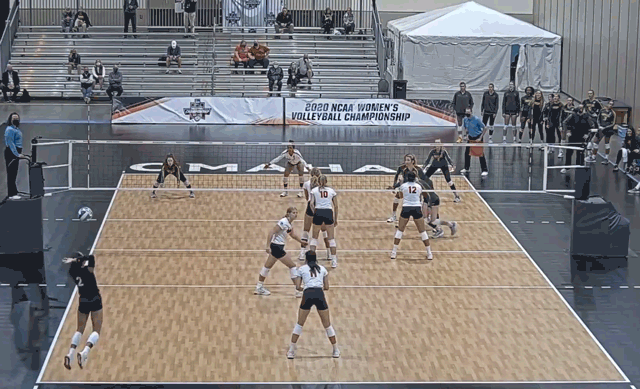
The next quickest type of attack is a quick middle attack, as shown below.
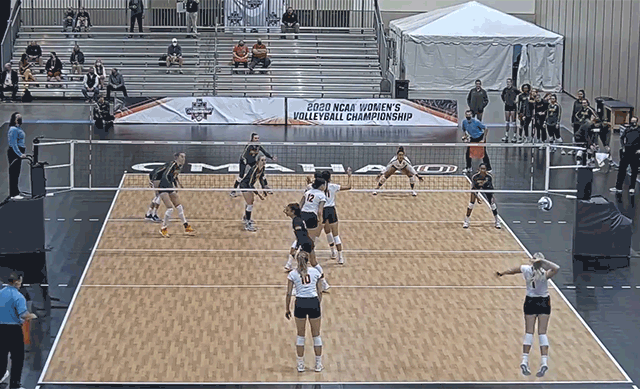
If we chart middle attackers, most heat maps will look something like this.
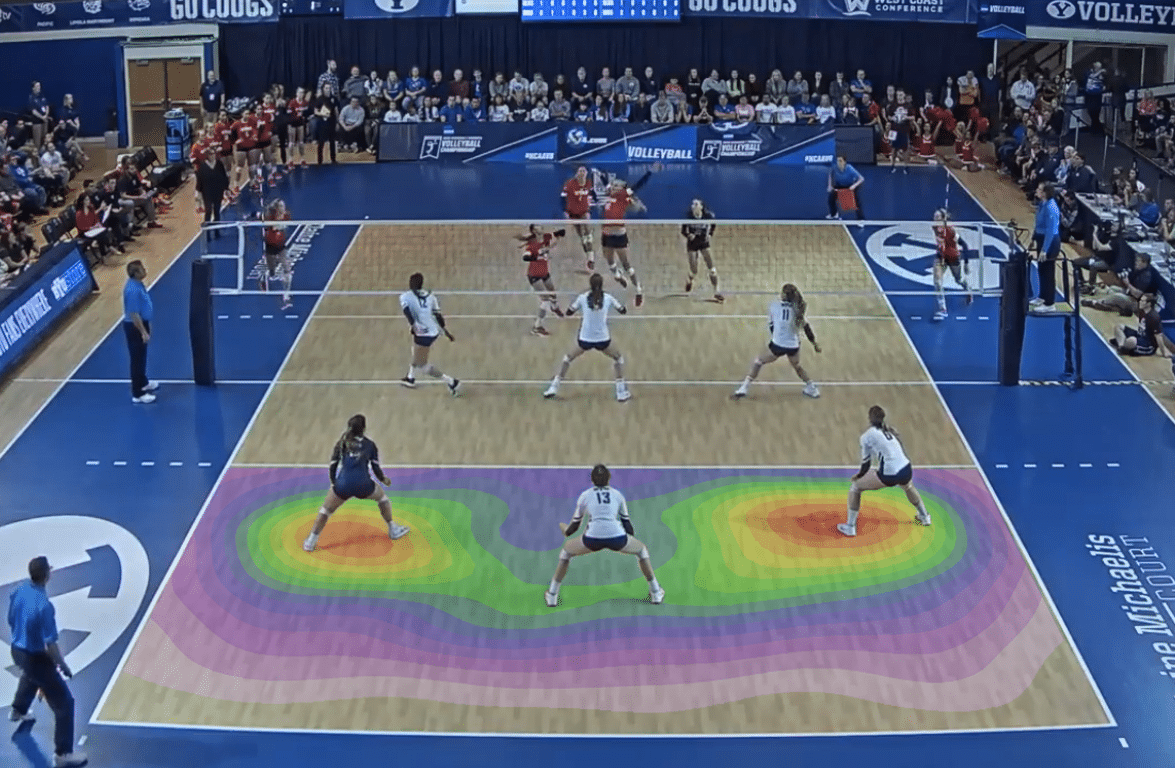
Because of where these fast types of attacks typically land, an added amount of responsibility is placed on the left-back and right-back defenders.
DO DIFFERENT SETS PLACE DIFFERENT DEMANDS ON OUR DEFENDERS?
We also need to have a general sense of where certain set types land in the court. Is it better to have a taller, longer athlete playing middle back where more balls might need to be played overhead (balls touching block, etc) or lunged towards (balls hit slightly to the left or right of middle-middle)? Is it better to have a quicker athlete playing left back where there is more responsibility for defending faster types of attacks? Are the hardest spikes being attacked to zone 5 or to zone 6? We would argue that more “clean” hard-driven balls go to zone 5, while more balls “off the block” are directed to zone 6.
WHO SETS WHEN THE SETTER DIGS THE FIRST CONTACT?
In today’s game, the majority of teams have shifted to having the libero take the second ball when the setter digs. If the libero is the out-of-system setter, one could argue that it’s easier to manage the setting responsibility from the left-back position. While this isn’t an absolute, we feel that the angles of the game make setting from this position simpler.
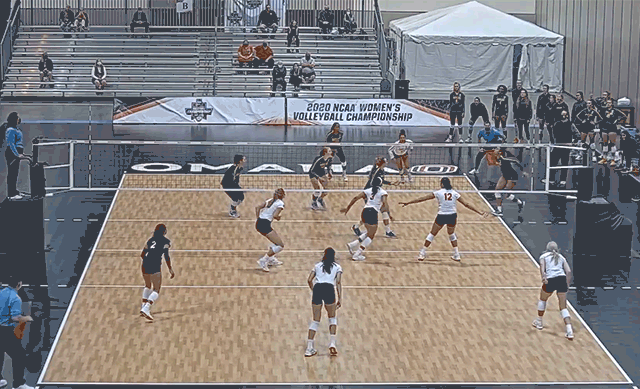
IS THERE A BACK-ROW ATTACK AND IS IT EFFECTIVE?
Attacking out of the back row in women’s volleyball has become more common, and more effective at the higher levels. That said, the “bic” and “pipe” are still not as prevalent as our front-row attack option, and even if it is, it is rarely more effective than a front-row attack. I think we can safely say that the higher the level (and power), the higher the odds of an effective back-row attack. The lower the level (lower power), the lower the odds of an effective back-row attack. Regardless, it’s worth doing some cost-benefit analysis to help determine where to have your libero play defense.
To illustrate how often back-row attackers are utilized, let’s look at the 16 women’s teams that advanced to the round of 16 in the 2022 tournament. These stats are from each team’s second-round victory that pushed them into the regional semi-finals.
| Team | NCAA Seed | Total Attacks | Middle-Back Attacks | % of Attacks to Middle-Back |
|---|---|---|---|---|
| Texas | 1 | 81 | 3 | 3.70% |
| Louisville | 1 | 119 | 7 | 5.88% |
| Stanford | 1 | 97 | 6 | 6.19% |
| Wisconsin | 1 | 73 | 5 | 6.85% |
| Pittsburgh | 2 | 125 | 2 | 1.60% |
| Minnesota | 2 | 77 | 3 | 3.90% |
| Nebraska | 2 | 152 | 8 | 5.26% |
| San Diego | 2 | 165 | 10 | 6.06% |
| Kentucky | 3 | 94 | 0 | 0.00% |
| Florida | 3 | 103 | 1 | 0.97% |
| Ohio State | 3 | 86 | 5 | 5.81% |
| Oregon | 3 | 134 | 20 | 14.93% |
| Marquette | 4 | 114 | 3 | 2.63% |
| Penn State | 4 | 112 | 3 | 2.68% |
| Baylor | 4 | 165 | 6 | 3.64% |
| Houston | 5 | 177 | 4 | 2.26% |
For 15 of the 16 sweet-16 teams, the middle-back offensive attack is a very small part of the team’s overall offense, even with the best attackers in the country on their rosters. High school and youth volleyball teams will likely attack from the back row even less.
Let’s put this into context. You may have a very good libero who is far and away your best defensive player. Your second-best defensive player may be an outside hitter who is great at attacking out of the back-row but struggles to dig balls consistently. If you find yourself in this situation, you may want to consider giving up the back-row attack and ensuring that your best defensive player (your libero) is playing where most of the balls go (typically the middle of the court).
If your libero and your back-row attacking outside hitter are similar in their digging abilities, then it makes for an easier decision. Keep your OH in the middle back while your libero would play left back.
WHAT ARE THE BEST TEAMS DOING?
All 16 teams in the 2022 round of 16 had their libero in volleyball play in the left-back position. While it is an option to have a libero play left-back in certain rotations, and middle-back in other rotations, this is less common.
LET’S SUMMARIZE – WHY ARE THESE TEAMS PLAYING THEIR LIBERO LEFT-BACK?
Below is an overview of why these collegiate programs are having their liberos play left-back rather than middle-back.
- The libero is responsible for digging clean, hard-driven attacks from opposing outside hitters.
- Most of these teams have outside hitters that are capable of digging balls in the middle-middle position without a significant drop in productivity.
- The libero is more available to help defend against set-overs and setter dumps.
- The libero is in a spot more likely to defend against middle attacks.
- The libero is more available to defend against tips.
- The angles of the game make it easier for a libero to set the second ball from left-back.
- Often times your outside hitters will be taller which allows them more defensive range (overhead and laterally) in the middle of the court.
- As a middle-back player, the outside hitter is available to hit from the middle-back — this becomes a more important consideration as power and ability increase. At the youth levels, we feel it would be more beneficial to have your best ball-control player in the middle back.
WHEN WOULD YOUR BEST DEFENDER PLAY MIDDLE-BACK?
- If your libero is far away the best defensive player on your team, and you know that the majority of balls at your level are landing or passing through the middle of the court. This scenario typically presents itself at younger, less powerful levels.
- If your back-row attack is not efficient, or you don’t set it, and your libero is your best defender, it would make sense to put them in the middle of the court.
- If you have tendency information on a specific opponent attacker that justifies putting your best defender in the middle of the court.
- If you have NO information on your opponent, we would recommend putting your best defender in the middle of the court (at least to start the match).
CAN YOUR LIBERO PLAY IN BOTH LEFT AND MIDDLE BACK?
Absolutely! In the 2022 NCAA national semifinal match against Louisville, Pitt’s libero played in both back-row spots.
Here you will see #12 is the yellow jersey playing left back.
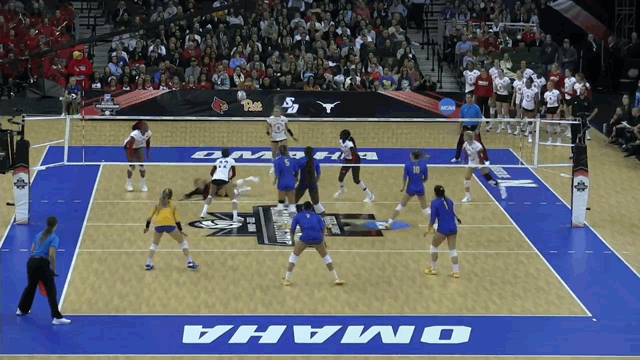
Here you will see #12 is the yellow jersey playing middle back.
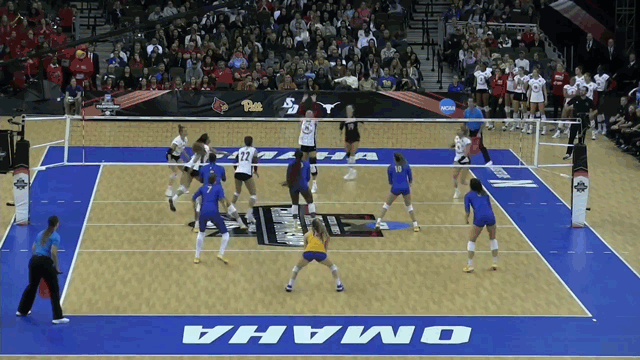
In this particular match, even though the libero played as both a left-back and middle-back defender, only one of her 20 dig attempts came from the middle-back spot. So, it should be noted once again that while this is an option, it’s not a commonly used tactic among these high-level teams. The decision to utilize this option is based on the abilities of other back-row players in specific rotations in comparison to the libero.
SUMMARY
If you truly understand what principles are, and how they can help you as a coach, you will quickly learn how liberating they can be. Often times we associate the word “principles” with rigidity. We believe it’s the opposite. Principles are liberating and will help you build truly effective systems based on data, trends, and the abilities of your players.
If you have any questions about the libero in volleyball, or need any clarification from this article, we are happy to help. Send us an email and we will get back to you shortly!
Email us at info@goldmedalsquared.com
Thanks for taking the time to read this article!


